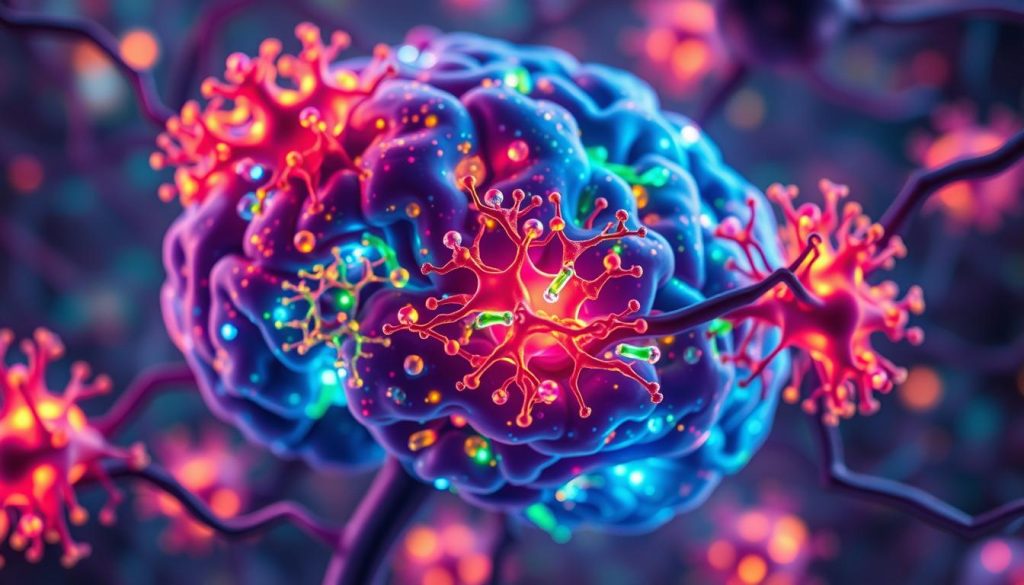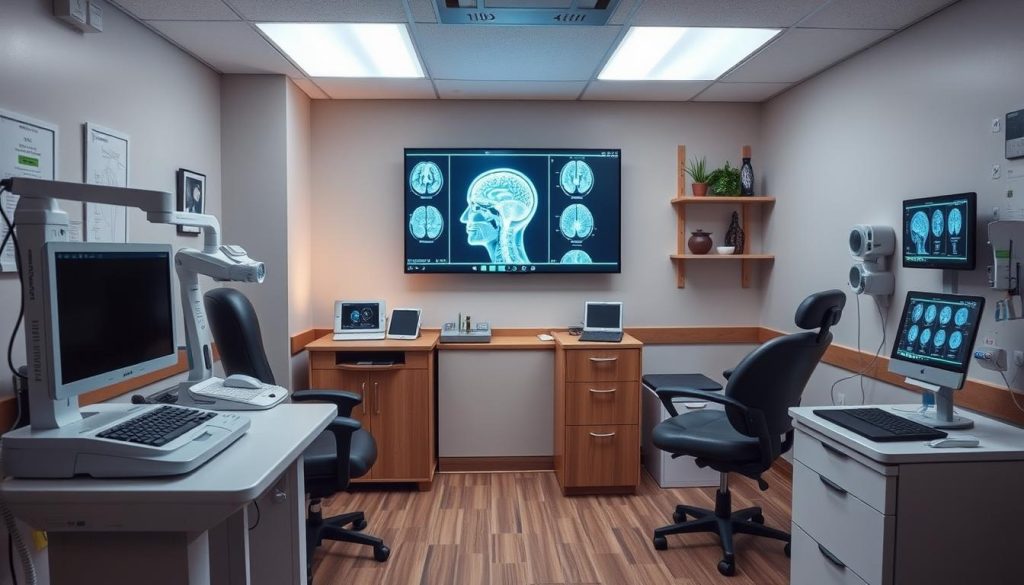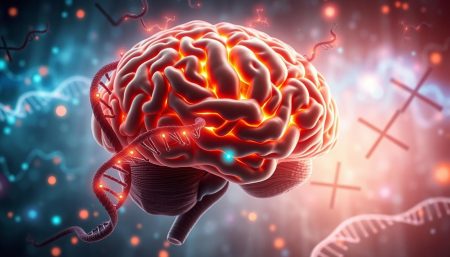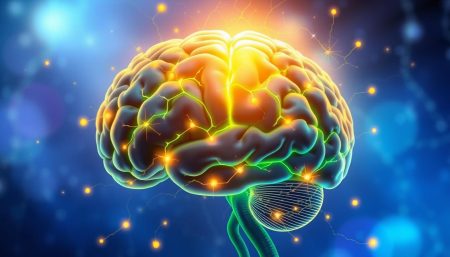The search for what causes Alzheimer’s and dementia is a deep dive into science. Alzheimer’s, a form of dementia, takes away memory and thinking skills. It’s a scary journey into the unknown.
Many factors, like genes, environment, and lifestyle, play a part in these diseases.
Groups like the Alzheimer’s Association and scientific studies offer a complete picture of these diseases. But, each case tells its own story of brain complexity.
We’re on the edge of discovering more about neurodegenerative conditions. This journey is not just about the brain. It’s also about hope and the chance to live a better life.
Key Takeaways
- Alzheimer’s and dementia are complex neurodegenerative conditions with multiple contributing factors.
- Understanding the causes of these diseases can lead to better prevention strategies and treatments.
- Research continues to uncover the myriad factors that contribute to these cognitive disorders.
- Both genetic predisposition and lifestyle choices play roles in the development of Alzheimer’s and dementia.
- The prevalence of these conditions underscores the impetus for ongoing research and societal awareness.
Understanding Alzheimer’s Disease and Dementia
Exploring Alzheimer’s disease and dementia starts with spotting early symptoms of dementia and signs of cognitive decline. These conditions show through various symptoms that harm our thinking skills. They affect millions worldwide, changing lives and families deeply.
First, let’s look at Alzheimer’s disease overview. It’s a main type of dementia that makes brain cells die. This leads to memory loss and thinking problems that get worse over time. It greatly changes how people live their lives.
According to the National Institute on Aging, finding symptoms of dementia early can help slow down the brain’s decline linked to Alzheimer’s.
- Memory loss that disrupts daily activities
- Challenges in planning or solving problems
- Difficulty completing familiar tasks at home, work, or leisure
- Confusion with time or place
- Trouble understanding visual images and spatial relationships
These signs are important for doctors and for people and families dealing with these issues. They help guide care and possible treatments.
Looking closer, we find stories of lives touched by these diseases. These stories are more than just struggles or medical histories. They show the human side of living with Alzheimer’s disease and dementia. They highlight the need for empathy, support, and full care in fighting these tough conditions.
So, talking about Alzheimer’s and dementia is not just about medical facts. It’s about a shared human experience. It shows our need for awareness, understanding, and action against these big challenges.
The Aging Brain and Neurodegenerative Decline
As more people age, it’s crucial to understand cognitive aging and the aging brain. Changes in the brain often lead to a decline in brain function. This makes people more likely to get diseases like Alzheimer’s and dementia.
Studies in Aging and Disease show how these changes happen. They find that smaller neurons and fewer neurotransmitters affect how the brain works. This makes it harder for the brain to process and remember things, especially as we get older.
Preserving cognitive function has become a crucial aspect of aging research, as maintaining mental agility can significantly enhance quality of life in one’s later years.
Some people stay mentally sharp even with brain damage. This is because of something called cognitive reserve. It’s the brain’s ability to find new ways to do things. This helps hide the signs of cognitive aging.

- Increasing Physical Activity
- Engaging in Mentally Stimulating Tasks
- Maintaining Social Connections
Each of these activities helps protect the brain from aging. They build a strong defense against neurodegenerative diseases. This keeps the brain healthy for longer.
Amyloid Plaques and their Role in Alzheimer’s
Learning about amyloid plaque formation in Alzheimer’s disease is crucial. It helps us understand how the disease starts and how we might stop it. These plaques are linked to other signs of Alzheimer’s, like neurofibrillary tangles and brain damage.
Defining Amyloid Plaques in the Brain
Amyloid plaques are made of beta-amyloid peptides, a protein that clumps in Alzheimer’s brains. This clumping is a key part of the disease. It blocks communication between nerve cells, causes inflammation, and leads to memory loss.
How Amyloid Plaques Contribute to Cognitive Deterioration
Amyloid plaques do more than just clump together. They also help create neurofibrillary tangles, making Alzheimer’s worse. These tangles and plaques damage brain cells, leading to memory loss and cognitive decline.
Understanding how plaques affect brain cells is key to fighting Alzheimer’s. It shows why some treatments don’t work and guides new approaches to tackle this complex disease.
Tau Proteins and the Disruption of Neuronal Functions

The talk about tauopathy sheds light on how tau proteins harm brain functions. These proteins help keep neurofibrillary tangles stable in brain cells. But, when they go wrong, they cause a chain reaction of damage, leading to big drops in thinking skills.
Abnormal tau proteins are the main cause of neurofibrillary tangles. These tangles mess up how neurons work by blocking the flow of nutrients and messages. As more tangles form, they damage neurons, making it hard for them to talk to each other. This is key for remembering things, making decisions, and learning.
| Healthy Neuron | Tau-Impacted Neuron |
|---|---|
| Stable microtubule | Collapsed microtubule |
| Efficient nutrient transport | Obstructed nutrient transport |
| Effective communication | Reduced communication |
It’s key to know how tau proteins go from helpful to harmful in the brain. They turn bad through a process called hyperphosphorylation, becoming stiff and twisted. This turns them into neurofibrillary tangles. Learning about tauopathy helps us understand Alzheimer’s better and why we need to focus on these proteins in treatments.
The effects of tauopathy go beyond just damaging neurons. It changes the brain’s structure over time, leading to noticeable shrinkage. This is a sign of advanced Alzheimer’s. So, tackling tauopathy is not just about treating symptoms. It’s about stopping or even reversing brain decline.
Genetic Factors in Alzheimer’s and Dementia
Alzheimer’s disease and dementia are deeply linked to genetics. This knowledge guides research and patient care. It helps us understand the genetics of Alzheimer’s and spot those at risk due to certain genetic mutations.
Identifying Genetic Markers
New discoveries have highlighted genes linked to Alzheimer’s. Genetic tests look for these genes to predict dementia risk. This helps tailor care to each person’s genetic makeup.
Familial Alzheimer’s Disease (FAD)
Familial Alzheimer’s is a form of early-onset dementia caused by genetic mutations. It’s passed down through generations, making it a type of hereditary dementia.
| Gene | Mutation Type | Linked Condition |
|---|---|---|
| APP | Formational | Early-Onset Alzheimer’s |
| PSEN1 | Secretase production | Familial Alzheimer’s Disease |
| PSEN2 | Secretase alteration | Hereditary Dementia |
Head Trauma as a Precursor to Neurological Disorders
Looking into how head trauma leads to neurological disorders is key. It shows how brain injuries can cause Alzheimer’s and dementia. Knowing this helps us prevent and treat these conditions.
Impact of Traumatic Brain Injuries
Traumatic brain injuries come from accidents or sports. They can have lasting effects on the brain. Even mild concussions can cause problems now and later.
Chronic traumatic encephalopathy (CTE) is a serious condition linked to head injuries. It affects boxers and athletes in contact sports.

After a TBI, people may have headaches and trouble thinking. This can really affect their life and work. Post-traumatic dementia is a big worry, showing possible long-term brain decline.
Studies on Concussions and Long-term Risks
Studies by the CDC have shown how concussions can lead to brain problems. Long-term studies link concussions to higher risks of neurodegenerative diseases.
| Study Focus | Findings | Implications |
|---|---|---|
| Sports-related Concussions | Increased prevalence of CTE symptoms | Enhanced protocols for sports safety |
| Non-sports-related Head Injuries | Links to memory loss and cognitive impairment | Importance of immediate medical evaluation |
| Recovery Outcomes of TBI | Variability in recovery, long-term care needs | Development of targeted rehabilitation programs |
In summary, knowing how brain injuries lead to cognitive problems is crucial. It helps doctors and caregivers find better treatments. It also shows the need for strong health policies and education to prevent head injuries.
Cardiovascular Health and Its Connection to Brain Health
The link between heart health and brain function is key to overall wellness. Studies show that heart disease and high blood pressure can raise the risk of vascular dementia. This is because they affect the brain’s health.
Good heart health means better blood flow to the brain. This is crucial for brain function. But, heart problems can harm brain abilities and lead to dementia over time.
| Heart Health Indicator | Impact on Brain Function |
|---|---|
| Blood Pressure Levels | High blood pressure can damage blood vessels in the brain, leading to cognitive decline. |
| Cholesterol Levels | Excessive bad cholesterol builds up in arteries, reducing cerebral blood flow and increasing the risk of stroke and dementia. |
| Heart Rhythm Irregularities | Conditions like atrial fibrillation can increase the likelihood of blood clots that could lead to strokes and subsequent brain function impairment. |
Keeping your heart healthy can help prevent vascular dementia and protect your brain. Managing cholesterol, controlling blood pressure, and preventing diabetes are good for both your heart and brain.
In summary, taking care of your heart is crucial for your brain’s health. It’s a holistic approach that keeps your heart strong and your mind sharp. This shows how closely our heart health and brain function are connected.
Inflammation and its Contribution to Alzheimer’s and Dementia
The link between chronic inflammation and Alzheimer’s disease is complex. It shows how brain inflammation speeds up dementia. Studies have found that long-term inflammatory response in the brain is key to Alzheimer’s disease. It harms cognitive health over time.
Chronic Inflammation and Neurodegeneration
Chronic brain inflammation is not alone. It works with other factors to worsen neurodegeneration. It starts a chain of toxic events in the brain, leading to damaged neurons and cell death. This cycle is fueled by inflammatory cytokines and reactive species, showing a strong immune response that can harm brain tissues.
The Immune System’s Role in Brain Health
The immune system’s reaction to threats in the brain is complex. Its protective aim can actually lead to Alzheimer’s by attacking brain cells. This shows the need for careful treatments to control the immune system in the brain. We want to reduce harmful inflammation while keeping the immune system’s protective role.

Dealing with neuroinflammation could be crucial in slowing or preventing Alzheimer’s. Treatments that manage brain inflammation could change how we keep cognitive health safe from Alzheimer’s.
The Role of Neurotransmitter Imbalance in Dementia
Understanding neurotransmitter activity is key to grasping how dementia symptoms emerge. An acetylcholine deficit is common in dementia, including Alzheimer’s. This neurotransmitter is vital for memory and learning.
Studies show that balancing neurotransmitters can ease dementia symptoms and enhance life quality. Yet, the link between neurotransmitters and brain functions is intricate. It involves many pathways and mechanisms.
| Neurotransmitter | Role in Brain Function | Impact of Deficit |
|---|---|---|
| Acetylcholine | Memory and learning | Decreased cognitive agility, memory gaps |
| Dopamine | Mood and reward | Increased risk of depression, negative mood swings |
| Serotonin | Well-being and happiness | Anxiety, mood disorders, and sleep disruption |
So, tackling neurotransmitter activity and understanding acetylcholine deficits is crucial. Targeted treatments can help lessen dementia’s impact. By rebalancing neurotransmitters, patients might see better cognitive and neurological health.
Investigating the Impact of Lifestyle Choices on Alzheimer’s and Dementia
Research into Alzheimer’s and dementia is ongoing. It shows that lifestyle choices, like diet and exercise, are key to brain health. They help lower the risk of these diseases.
Nutrition and Brain Health
The idea of a neuroprotective diet is becoming more popular in nutritional neuroscience. Research finds that diet greatly affects brain health. Foods high in antioxidants and healthy fats, and low in sugar, support the brain.
The Mediterranean and MIND diets are good examples. They help slow down cognitive decline.
- High in vegetables, fruits, whole grains, and seafood
- Low in red meats and sugary foods
- Includes nuts and olive oil, rich in healthy fats
These foods are crucial for Alzheimer’s prevention. They fight oxidative stress and inflammation. These are big factors in Alzheimer’s and dementia.
Physical Activity’s Protective Effects
Exercise is also vital for brain health. An active lifestyle boosts both physical and mental health. It increases blood flow to the brain, helping fight aging and disease.
- Aerobic exercises, such as walking or cycling
- Strength training, which can also improve neural connections
- Balance and flexibility routines, which help maintain overall mobility
Exercise helps the brain stay connected and make new connections. This is important for keeping the mind sharp. It plays a big role in Alzheimer’s prevention.
Exploring the Influence of Social and Cognitive Engagement
Social interaction and mental engagement are key to building cognitive reserves. Studies show they help delay or lessen dementia and Alzheimer’s symptoms.
Mental stimulation from puzzles, reading, or learning new skills is vital. So is social interaction through talks and community activities. These keep the brain healthy by making new connections and fixing old ones.
Let’s dive into how these elements work together:
- Learning and facing mental challenges boost mental stimulation.
- Staying active socially and building personal connections is good for social interaction.
- Together, they help keep cognitive reserves strong, which is key for brain health over time.
Research also shows that social and mentally stimulating activities can protect against cognitive decline in older age.
| Activity Type | Benefits for Brain Health |
|---|---|
| Engaging in group sports or clubs | Enhances social networks, increasing social interaction and emotional support |
| Regular participation in puzzles and games | Improves problem-solving, boosting mental stimulation and cognitive function |
| Attending lectures or cultural events | Exposes to new ideas and perspectives, vital for cognitive reserves development |
The cycle of social interaction and mental stimulation builds cognitive reserves. It also improves life quality, offering strong protection against neurodegenerative diseases.
The Significance of Early Diagnosis and Intervention
The importance of early detection in dementia management and Alzheimer’s interventions is huge. Finding the disease early can slow it down and give time for treatments. This helps keep the mind sharp and improves life quality.
New tools and treatments help doctors spot dementia signs early. This means they can create care plans that fit each person’s needs.

Early diagnosis opens a window for treatment and helps manage the disease’s effects. Families get time to plan for the future. Patients can also make choices about their care, improving their relationship with caregivers.
| Benefits | Impact |
|---|---|
| Slowed Progression | Extends quality of life |
| Targeted Interventions | Higher precision in treatment, tailored to patient history |
| Enhanced Planning | Allows families to prepare cognitively, emotionally, and financially |
Starting therapy and making lifestyle changes early is key in managing dementia. Early treatment can greatly improve mental health and slow cognitive decline.
Early detection means more years of independence and a chance to join clinical trials. These trials are crucial for finding new treatments for Alzheimer’s.
- Regular cognitive assessments
- Adoption of brain-healthy lifestyle modifications
- Use of advanced imaging technologies for detailed brain scans
In conclusion, early detection and timely Alzheimer’s interventions are vital for managing dementia. They change the course of this serious disease.
Emerging Research and Future Potential Treatments
Scientists are making big steps towards finding a cure for Alzheimer’s disease. They are exploring new ways to treat and prevent Alzheimer’s. This includes research on neuroregeneration and genetic engineering.
Towards a Cure: Breakthroughs in Medical Science
Researchers are working on treatments that could stop or even reverse Alzheimer’s. They are studying how to fix damaged brain connections. This could lead to better thinking skills.
New medicines are being developed to prevent Alzheimer’s. These drugs aim to change the disease’s course. They could be a game-changer in treating dementia.
Preventative Strategies and Holistic Approaches
There’s also a focus on preventing Alzheimer’s through lifestyle changes. This includes better diet, exercise, and mental activities. These steps can help delay symptoms of Alzheimer’s.
Studies show that a healthy lifestyle can reduce Alzheimer’s risk. Activities like mental games, socializing, and even yoga can help keep the brain healthy. These holistic treatments are important for overall brain health.
By combining medical research with holistic treatments, we may see a future where Alzheimer’s is preventable. This could change the way we manage and treat dementia.
Conclusion
We’ve explored the complex causes of Alzheimer’s disease and dementia. We’ve seen how amyloid plaques and tau proteins harm brain cells. We also learned about the big role genetics, lifestyle, and environment play.
Understanding Alzheimer’s is key to fighting it. Dementia awareness and education are crucial. They help us tackle this condition that affects millions worldwide.
As dementia awareness grows, supportive care becomes more important. It includes medical help and care from families and healthcare teams. This knowledge helps us deal with Alzheimer’s and dementia better.
It’s vital to get diagnosed early and have care plans tailored to each person. This approach makes a big difference.
Our goal is to create a world ready to fight Alzheimer’s disease. By spreading dementia awareness and improving care, we make a big impact. Together, we can make a difference in the lives of many.
FAQ
Q: What are the main causes of Alzheimer’s disease and dementia?
A: Alzheimer’s and dementia come from many factors. These include aging, genes, environment, and lifestyle. Things like amyloid plaques, genetic mutations, and lifestyle choices play a big role.
Q: How does aging affect the brain and contribute to cognitive decline?
A: As we age, our brain changes. It shrinks, blood flow decreases, and neurons don’t talk as well. These changes make us more likely to get Alzheimer’s and dementia.
Q: What role do amyloid plaques play in Alzheimer’s disease?
A: Amyloid plaques are protein clumps in the brain. They block cell communication and cause brain damage. This leads to memory loss and other symptoms of Alzheimer’s.
Q: Can head trauma lead to dementia?
A: Yes, head trauma can lead to dementia. Severe or repeated head injuries can damage brain tissue. This damage is linked to conditions like chronic traumatic encephalopathy (CTE).
Q: How do genetic factors influence the risk of Alzheimer’s and dementia?
A: Genetics are key in Alzheimer’s and dementia. Genes like APOE-e4 increase the risk. Familial Alzheimer’s Disease is caused by inherited genetic mutations.
Q: Why is cardiovascular health important in relation to brain health?
A: Heart health is vital for brain function. A healthy heart pumps blood to the brain. Without it, the brain can’t get the oxygen and nutrients it needs.
Q: What impact does lifestyle have on Alzheimer’s disease and dementia?
A: Lifestyle choices affect brain health. Eating well and exercising can lower dementia risk. Bad diet and lack of exercise can increase it.
Q: How does chronic inflammation contribute to Alzheimer’s and dementia?
A: Chronic brain inflammation harms brain cells. It leads to damage and affects memory. Inflammation markers are high in Alzheimer’s patients, showing a strong link.
Q: Are there any preventive measures for Alzheimer’s disease and dementia?
A: Preventing Alzheimer’s and dementia is not guaranteed. But, good heart health, exercise, and a balanced diet help. Managing stress and getting enough sleep also matter. Early detection and treatment can slow symptoms.


















